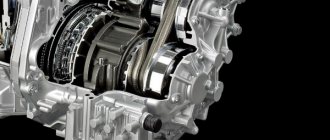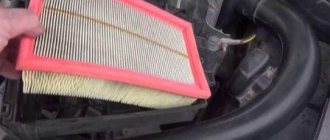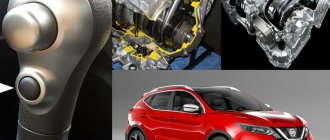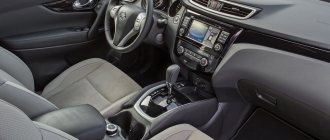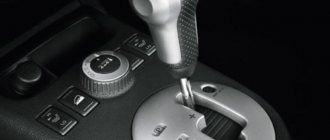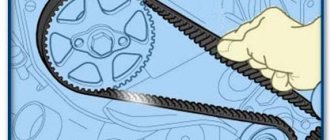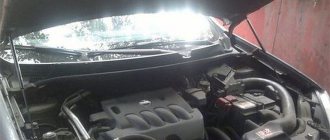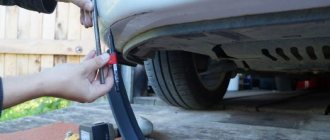Despite the fact that CVTs are considered quite reliable, things didn’t work out right away on Nissan Qashqai cars. There were two mass failures of similar units: in 2012 and 2014. At the same time, new firmware helped correct this situation. Now the devices are working correctly, so there is no need to worry about their reliability. Moreover, the manufacturing company provides a guarantee of up to 100 thousand kilometers. The Jacto brand, which supplies gearboxes for Nissan, guarantees high-quality gearbox operation for up to 120 thousand kilometers.
In today's article we will talk to you about what CVTs are installed on the Nissan Qashqai, why they fail and how to extend the life of the gearbox of this car
What kind of variator is installed on Nissan Qashqai
Nissan Qashqais with an automatic transmission are equipped with a new generation CVT transmission, developed by the Japanese manufacturer together with Jatco specialists. When setting up this system, Nissan engineers took the Multitronic transmission from Audi as a basis.
The new generation of traditional V-belt CVTs is complemented by improved components that will reduce the size of the entire system by 10% and significantly reduce the weight of the unit. Next, we will briefly consider the principle of operation of the Nissan variator.
The principle of operation of a CVT gearbox is to simultaneously change the dimensions of the diameters of the drive and driven shafts. The diameter sizes are changed using a special drive depending on the operating modes of the engine. When the car starts moving, the drive shaft of the box has a minimum diameter, and the driven shaft has a maximum diameter.
When the vehicle accelerates, as the engine speed increases, the diameter of the CVT drive shaft begins to increase. At the same time, the diameter of the driven shaft decreases, resulting in a reduction in the gear ratio. If the car accelerates on the road, the CVT maintains optimal speed, which provides the greatest power and excellent dynamics of the car.
Replacement with automatic
Having suffered with CVTs of the first generations, many Nissan Qashqai owners are thinking about replacing it with an automatic transmission. Because such Nissan boxes are more reliable. Advantages of branded machines:
- High cross-country ability in off-road conditions;
- Load capacity is higher than that of CVTs;
- There is less wear and tear during aggressive driving;
- Increased wear resistance;
The only drawback of the automatic, in comparison with the CVT, is its lower efficiency. The replacement is not difficult, provided that the automatic transmission is compatible with the engine of the CVT car. Many service centers will perform the replacement. It makes sense to replace the transmission if repairs are more expensive or equal to the cost of a new automatic transmission.
What should the oil level be in the Nissan Qashqai variator?
In order to correctly check the oil level in the Nissan Qashqai variator, you must perform the following procedure:
- The oil in the variator must be heated to 50-80 degrees C. To do this, the manufacturer recommends warming it up while driving. At an ambient temperature of 20 degrees C, the required oil temperature in the variator is achieved according to the recommendations after about 10 minutes of driving in normal mode.
- After the run, we stop the car on a level surface and do not turn off the engine.
- Apply the handbrake securely.
- With the brake pedal pressed, move the variator mode switch lever to all positions one by one, holding each position for a few seconds.
- Move the mode selection lever to position P or N. The engine should continue to run.
- We remove the oil level dipstick by releasing the latch of the dipstick head mechanism.
- We wipe the dipstick from oil using special or any smooth paper. Do not use rags or other materials to wipe the dipstick that could leave behind pieces of material, threads or other foreign bodies.
- We insert the probe back, turning the probe head 180 degrees relative to its original position!!!!!
- We take out the dipstick and check the oil level according to. probe sector.
- We insert the probe back, turning it over again and placing the probe head in its original position, which was in the latched position of the head.
- Securely lock the probe head lock.
- The same oil level in the variator with the engine not running and with the engine running may indicate a malfunction of the oil pump or its beginning.
Frequent breakdowns
The Nissan Qashqai J10 was equipped with CVTs JF015 and JF011. After 2013, respectively - for Nissan Qashqai 2.0 - JF016 and JF017. The first experiments with this type of transmission were not very successful. The latest versions of the box are highly reliable, which cannot be said about the first ones. The most problematic is the 15th episode. The most reliable CVT Nissan Qashqai is equipped with a 1.6 turbocharged engine. Let's look at the most common problems with Nissan Qashqai CVTs.
Extraneous sounds
Noises, extraneous sounds, hum during operation of the variator can occur for various reasons. Most often, bearing wear is to blame. During operation, wear products, dirt, and metal shavings get on them. Magnets are not always able to retain all particles one hundred percent.
First of all, wear depends on the quality of the bearings themselves, secondly - on the quality of the lubricant and the regularity of its replacement. They may also not be able to withstand the load due to their weak load capacity. The first problems can make themselves felt when the mileage reaches 50 thousand km. The appearance of a hum during acceleration is a sure sign.
Oil pump problems
The oil pump is also affected by neglect of timely and competent maintenance. Failure to change the oil and filter on time leads to the accumulation of deposits and excess metal shavings. The pump is forced to pass all this through itself. Of course, some of the deposits remain inside it, which impairs the operation of the pressure relief valve.
As a result, the valve gets stuck, and the pressure required for the correct operation of the entire system drops. This can manifest itself as slippage and failures during acceleration. Over time, the car may simply stop at the wrong time.
Belt slipping on cones
This problem may stem from the previous one. Problems with the oil pump lead to a drop in pressure in the system, which results in the belt starting to slip along the cones. When the car is running, this is felt as vibrations and causes uneven acceleration. And it can lead to belt rupture. This is a sudden immobilization of the vehicle, which creates an emergency situation.
Hydraulic unit
Repair of the valve body is often required because it is one of the weakest points of the variator. When it fails, floating speed occurs. And acceleration is carried out with jerks and jerks. Until relatively recently, there were no car services capable of repairing the valve body. Therefore, it was completely changed. Now, in most cases, certain problems are corrected.
Errors
You can also often find complaints from motorists that the Qashqai variator produces the same errors. For example, what does the P0725 code mean? It indicates that the problem is related to the input circuit of the engine speed sensor. May indicate:
- damage, corrosion of wires;
- poor electrical connection in the sensor circuit;
- problems with transmission fluid;
- failure of engine sensors;
- defects in gear shift solenoid valves.
CVT error P0826 is also common. She talks about faulty manual shift switch.
Which oil is best for the Nissan Qashqai variator?
Nissan Qashqai car owners often wonder which oil is best for CVT gearboxes? Let's try to answer this question now.
So, let's begin. There are only two types of oil in the Nissan Qashqai variator. This is the transmission fluid Nissan CVT Fluid NS-2 or Nissan CVT Fluid NS-3, as well as analogs of these fluids from other class=”aligncenter” width=”849″ height=”436″[/img]
As mentioned above, the oil in the Nissan Qashqai variator must comply with NS-2 or NS-3 approval. So which one is needed? Earlier models of Nissan Qashqui are suitable for NS-2 oil, and the latest ones are suitable for NS-3 fluid. We will deal with this in detail.
- The perfect oil for Nissan Qashqai J 10 is: Transmission fluid Nissan CVT Fluid NS-2 Article number: 0.946 l – 999MP-NS200P / 4 l – KLE52-00004 / 20 l – KLE52-00002. Volume for a complete replacement is 8.3 liters.
- Nissan Qashqai+2 JJ10 Transmission fluid Nissan CVT Fluid NS-2. Article: 0.946 l – 999MP-NS200P / 4 l – KLE52-00004 / 20 l – KLE52-00002. Volume for a complete replacement is 8.3 liters.
- Nissan Qashqai J11E: Transmission fluid Nissan CVT Fluid NS-3 Article: 0.946 l – 999MPNS300P / 4 l – KLE53-00004 / 20 l – KLE53-00002. Volume for complete replacement 7.4 l
So, we have sorted out the question of what and how much oil to pour into the Nissan Qashqai variator.
Cost of services
The cost of repairing any transmission is not cheap, and the CVT is no exception. It costs approximately 12-15 thousand rubles, depending on the complexity of the breakdown. I will give approximate prices for repairs in rubles:
- Complete replacement – from 18 thousand;
- Replacement or repair of the hydraulic unit – from 18 thousand;
- Replace the variator belt - from 16 thousand;
- Lubricant change - about 1.5 thousand;
- Repair of hydraulic transformer from 8 thousand;
It’s easier not to run the transmission until it’s in a deplorable state; prices are given without taking into account the cost of spare parts. A new variator costs from 35 thousand. For independent repairs, you need to know the device and have the necessary tools, plus practical experience, which not every specialist has.
Because CVT gearboxes are a new word in the world of automotive technology.
How to check the oil in a Nissan Qashqai variator
In order for the fluid level in the variator to be checked accurately on a Nissan Qashqai, place the car on a flat horizontal surface. The engine should be running at idle speed, i.e. Do not turn off the engine. Without releasing the brake pedal, you should sequentially move the selector through all positions - P, R, N, D. The delay in each position should be about 5-10 seconds.
After this run, you must set the selector to mode P, after which you can release the brake pedal.
Get out of the car and open the hood. You need to remove the dipstick from the variator filler neck. For those who have never done this, you should know that the neck is marked with the inscription “TRANSMISSION”, and on some modifications - CVT. To release the probe, press the lock on the probe and unlock it.
If you crawl under the hood empty-handed, you'll have to return to the car and grab a rag. The dipstick needs to be wiped dry. Make sure that there are no small particles of matter left on it. The rags must be clean and dry to prevent the ingress of dirt and water. It is better not to carry out the test during rain or snow, which can also lead to moisture getting into the liquid.
After cleaning the dipstick, it should be lowered back into the neck until it stops, leave for a short time and remove the dipstick again. Watch the latch: it should be positioned so that the probe does not snap into place. At the end of it you will see marks. They indicate the level. This is how the fluid level in the variator is checked on a Nissan Qashqai.
Normally, the liquid reaches an average value between the minimum and maximum marks marked on the surface of the dipstick, i.e. the end of the oil part is located in the hot range. If you don’t see such a mark on the dipstick, then look for marks of a different kind. It could be:
* add - 1pt; * don't - full - max. After checking, lower the dipstick back into the neck until it stops so that the latch engages. This completes the check.
Design and principle of operation
The Nissan Qashqai CVT has the internal designation CVT (Continuously Variable Transmission) and is produced by the Japanese company Jatco. On Qashqai cars of the old J10 model, a RE0F10A or JF011E V-belt variator was used; the new Qashqai J11 is equipped with a modernized JF016E variator. The main difference is the gear ratio of the main pair (6.466 and 6.386, respectively) and the range of gear ratios (2.349 – 0.394 and 2.631 – 0.378, respectively).
The design of such a box has two independent pulleys mounted on bearings and equipped with two cones each, with the narrow sides of the cones located opposite each other. One pulley is connected to the engine crankshaft, the second pulley is on the shaft that goes to the differential box. Torque is supplied from the engine crankshaft through a torque converter. A steel plate belt is installed between the pulleys, with the help of which torque is transmitted. A planetary gear is used to transmit torque to the driven shaft. The belt can move along the side surface of the cones, thereby constantly changing the gear ratio.
Nissan Qashqai variator shafts assembled with drive belt
When starting from a standstill, the belt is located on the drive pulley at the minimum diameter (cones spread apart), and on the driven pulley at the maximum diameter (cones closed). The distance between the cones is changed by a stepper motor and a rotation speed sensor installed in the valve body housing.
Decoding of schemes:
- Fixed tapered drive shaft pulley.
- Movable conical pulley.
- Movable tapered pulley of the driven shaft.
- Steel belt.
- Fixed tapered pulley.
- Planetary gearbox with built-in multi-disc brake.
From the drive shaft, using a pair of helical gears, rotation is transmitted to the differential. As acceleration progresses, the gear ratio changes in such a way as to maintain the most favorable engine speed from the point of view of dynamics and fuel consumption. To switch the direction of movement, the variator design uses a multi-disc brake.
The diagram below shows how a modern CVT works. Red arrows indicate the direction of movement of torque from the engine.
CVT circuit
Explanation of the scheme:
- Drive shaft.
- Oil pump drive chain (can be from a pair of gears).
- Torque converter.
- Differential.
- Steel variator belt.
- Secondary shaft cones.
- Driven shaft.
- Planetary reductor.
- Drive shaft cones.
The most important indicator of the efficiency of any gearbox is the power range, which is the ratio of the highest and lowest gears in the transmission. In modern multi-speed automatic transmissions, the range value does not exceed 9 units, while the latest CVT examples allow a value of about 12 units.
How long does a variator last?
Due to two cases of mass failures of Nissan Qashqai CVTs, they have acquired a reputation as extremely unreliable units with a short resource. The first problems were on 2012 cars with a naturally aspirated 1.6-liter engine. The reason was the poorly adjusted kinematic scheme of the variator for a small engine. The second problem arose in 2014 on the new Nissan Qashqai J11 due to new firmware of the control unit. Two firmware versions were released, PM463 and PM551, which corrected the situation. Starting from 2014, the plant provides a guarantee for Nissan Qashqai CVTs for 100 thousand kilometers. At the same time, the Jacto company, which supplies these units to Nissan, provides a warranty mileage of 120 thousand km.
Subsequent operation of the vehicles showed that the variator is quite reliable and runs smoothly without repair for more than 200 thousand km. According to reviews from owners, the Qashqai engine requires major repairs earlier than a regularly serviced variator.
Self-diagnosis of the Nissan Qashqai variator
Before you begin diagnosing the variator, the engine and transmission must be warmed up while driving. Some car instructions require connecting Consult and checking the temperature sensor in the CVT box. The voltage there should exceed 0.9V. Simply put, you need to drive a few kilometers before diagnosing the variator. The sequence of actions in preparation for self-diagnosis of the CVT gearbox is as follows:
- Warm up the car while driving.
- Disconnect all consumers of electrical energy from the battery.
- The battery is in good condition with a charge of more than 12 V.
- There are no alarms that break the standard circuits.
- The gearbox selector is moved to position “P” - Parking.
The procedure for diagnosing a CVT transmission:
- Insert the key into the lock and turn it to the ON position.
The warning lights on the dashboard should light up. Carry out the procedure quickly twice OFF- ON – OFF – ON – OFF. Leave it turned off.
- Switch on the ignition with the gear selector in position P and turn on the ignition. Wait until the CVT (Sport) light comes on for a couple of seconds and then immediately turn off the ignition.
- Press the brake pedal and move the selector to “D” – Drive.
- Turn the ignition back on.
- Release the brake pedal and move the selector knob to position L.
- At the same time, fully depress the brake and gas pedals and move the selector back to D.
- Release both pedals.
First, there will be a starting pulse of 2 seconds, as when you turn on the ignition, then the lamp will flash 10 times, at this time you need to look at the flashes. Some of them will be short, about half a second, some longer, about a second. Let's assume that the self-diagnosis procedure did not start for some reason.
If the variator is constantly in emergency mode, then first check the condition of the Step Motor windings at the box connector under the battery. Through this connector you can diagnose all internal electronic components of the variator. If you replace them, you will have to drain the oil and remove the pan with filter.
If the malfunction is complex and does not always manifest itself in motion, then measurements must be taken from external speed sensors and directly in motion. On passenger cars, this connector is usually located in the center of the dashboard. On minivans - under the glove compartment on the passenger side, closer to the left pillar.
If the car moves in the emergency mode of the variator, both on a warm and cold engine, then there is a high probability that the Step Motor has failed (the winding has broken). A malfunction that occurs after warming up is the rotation sensors. In this case, you need to disassemble everything to access the ECU and go actively driving for about ten minutes. Once this time has passed, connect the device and watch the signals.
If the variator begins to slip, then check the pressure in the port and the voltage at the pressure sensor in Stall Test mode. This will help you learn a lot about the condition of the CVT gearbox. In order not to move on a “keg of gunpowder”, if you purchased a used car with a CVT, the mileage of which has already reached a critical number, change the transmission at the first maintenance so as not to spoil your life with restless thoughts.
Operational resource
| Overhauls are usually required at mileages of about 200 thousand; after restoration, the gearbox will be able to run another 150 thousand. At the same time, the service life depends on the correct maintenance of the transmission and the driving style. |
CVTs are often called a city gearbox, so such a transmission does not withstand fast long-term driving or aggressive acceleration, which significantly reduces its service life.
The main reasons for the failure of the variator on the Nissan Qashqai
As we have already said, not many people still believe in the reliability of CVTs. There is an opinion that they are very capricious, and it is not advisable to repair them due to the high cost of components. Official dealers practically do not carry out repairs; in most cases, a broken variator is simply replaced with a new one, the cost of which will shock the owners. By the way, the same fate awaits the owners of conventional hydromechanical “automatic machines”. Despite this, some workshops, taking advantage of the current situation, have mastered the repair of CVTs. Information from one of the representatives of such a service was used when writing this publication, which we hope will dot the i’s. To a greater extent, Jatco CVTs can be found on cars of the Renault - Nissan concern; one of the common models is JF011E. Such a variator is most often installed on the Nissan X-Trail in the T-31 body, as well as on the Qashqai and Teana. Manufacturer Renault equips JF011E for Megan, Latitude, Fluence, Scenic and Koleos cars.
Also, Jatco CVTs are often used for their models by Mitsubishi (Lancer, Outlander) and the French manufacturers of cross-platform crossovers Citroen C-Crosser and Peugeot 4008. But that’s not all. Jeep Compass, Suzuki Kizash, Dodge Caliber are also equipped with Jatco JF011E CVTs. Using this model as an example, we will tell you what diseases are found in continuously variable transmissions.
CVT modifications
A variator (CVT) has been installed on Nissan Qashqai cars since the very beginning of production, that is, since 2007. In 2010, the car was restyled, but the CVT gearbox remained virtually unchanged.
In 2014, Nissan releases the updated Qashqai. This time the gearbox was also modernized.
Nissans have CVTs from the Japanese company Jatco. The new Qashqai received an improved model based on the previous JF011E. Box JF011E (other marking RE0F10A) is very popular. It was released in 2004 and is intended for engines from 1.6 to 2.5 liters.
It was the result of the modernization of another box RE0F06A, which has been produced since 1999 and was also deservedly appreciated.
Thus, at the moment, two types of JF011E can be found on Qashqais: the model before 2014 and the updated one after 2014. A similar box is installed on Dodge Caliber, Jeep Compass, Citroen C-Crosser, Renault (Scenic, Megane, Koleos), Peugeot 4007, some Mitsubishi and Samsung cars, and, of course, Nissan Qashqai, X-Trail, Tiida and Teana.
Nissan Qashqai variator hums
Most often, bearings fail in a variator. Their wear is accompanied by a characteristic hum. The first signs of a malfunction may appear after a mileage of 50,000 km. To change four bearings in a workshop you will have to fork out 35,000 rubles. Most often, such a malfunction occurs on Nissan Qashqai cars, less often on Nissan X-Trail and, to a lesser extent, on Mitsubishi Outlander. By the way, in Outlander the first signs of bearing wear appear after a mileage of 150,000–200,000 km.
There are a number of reasons why bearing noise can occur. In the first place, wear products may get on the working surfaces of the variator parts, which subsequently leads to their rapid wear. And even two oil filters with a magnet, which are provided by the design, are not able to clean the oil from metal particles. Some experts believe that by reducing the oil change interval in the variator to 30,000–50,000 km, destruction can be avoided and the service life of the bearings can be increased. But in practice it has been proven that frequent oil changes and scheduled oil changes do not play any role in the service life of bearings. There are many examples when on one variator the hum starts already within the first 50,000 km. mileage, and the other, under similar operating conditions, calmly maintains 100,000–120,000 km. Based on this, the conclusion suggests itself - the quality of the bearings themselves is to blame. Also, one should not exclude another reason for the premature failure of the variator - the bearings cannot withstand loads due to weak dynamic load-carrying characteristics.
Returning to the oil change interval, each manufacturer sets its own regulations. Renault - Nissan, for example, recommends only monitoring the level and condition during the warranty period (100,000 km), but Mitsubishi obliges car owners to change the oil in the variator every 75,000 km. As for the oil used in continuously variable transmissions, it is specific and has the index CVT. The original fluid used on Nissans is called NS-2. Renault recommends filling in ELFMATIC CVT, Mitsubishi DiaQueen CVT-J1. All these oils are the same type. The use of fluids for hydromechanical automatic transmissions in a variator is strictly prohibited, however, continuously variable transmissions from other manufacturers are already appearing in which the use of such oils is permissible, but this is largely an exception to the rule. As for the volume of oil used, it all depends on the type of drive and the power unit itself. So for a front-wheel drive Nissan Qashqai, which has a 2-liter engine without an oil cooler, 4.2 liters will be needed for replacement. I would like to note that some of the oil always remains in the hydraulic system and transformer and cannot be drained during normal replacement. To perform a complete fluid change in the variator, the replacement method is used using special equipment. In this case, you will need 2.5–3 times more oil to replace.
Features of driving with a variator
The most important principle of using this type of box is that you need to warm it up if the temperature outside is low.
This is due to the fact that the oil used in it has its own special characteristics. When it's cold outside, the oil cools, it becomes viscous, and it takes time for it to spread throughout the entire transmission. To drive a CVT when there is severe frost outside, it should take about 30 minutes (at least) to warm up, and after that you can drive the car safely. But even when moving for some time, you need to follow certain rules. Operation during the first 5 km should be very careful, you should drive without sudden jerks. This is necessary so that the lubricant is distributed throughout the entire system.
An oil change is required every 40,000 km. Be sure to use only high-quality fluid, since the variator only works properly with it. On Qashqai, the variator has its own characteristics and “nitpicking” regarding the quality of the hydraulic fluid.
There are several rules when overtaking and turning in a Nissan CVT. This type of transmission responds to an increase in engine speed. Therefore, to change the gear ratio, you will need to increase the speed. Afterwards, the variator, following the selected mode, will perform the actions required of it, albeit with a slight delay.
Based on the same rule, controlled overtaking should be done when the speed has increased. And when you take turns, you need to press the gas exactly at the moment when you turn the steering wheel.
If you use the variator correctly, you can operate it for many years.
Procedure
If the listed symptoms are observed on your Nissan Qashqai, then you need to consider replacing the outboard bearing.
The process is not very simple, but, nevertheless, we can do it on our own, which will help save several thousand rubles. The instructions look like this:
- The car is placed on a jack or lifting platform; you need to gain access to its front.
- The wheel of the damaged drive is removed.
- The ball joint is knocked out.
- The hub nuts and steering tips are dismantled.
- The drive is removed from the hub.
- The bolts that secure the catalyst to the car body are removed.
- The bolts securing the drive assembly are removed. There are seven of them in total; dismantling some of them is very difficult, so you will have to tinker.
you will have to jack up the engine
- The engine is supported by a jack.
- The drive shaft is removed. During the removal process, a large amount of oil may spill out of the gearbox, which must subsequently be compensated for.
- The bracket is removed by unscrewing a pair of fixing bolts.
- The bearing is knocked out of the housing, the anthers are dismantled.
It is very difficult to diagnose the “bearing”; it does not play or rattle. But it rotates very hard.
- The stopper is dismantled, the bearing is removed, and a new part is installed in its place.
Drive shaft oil seal (right). 38342-8E001
